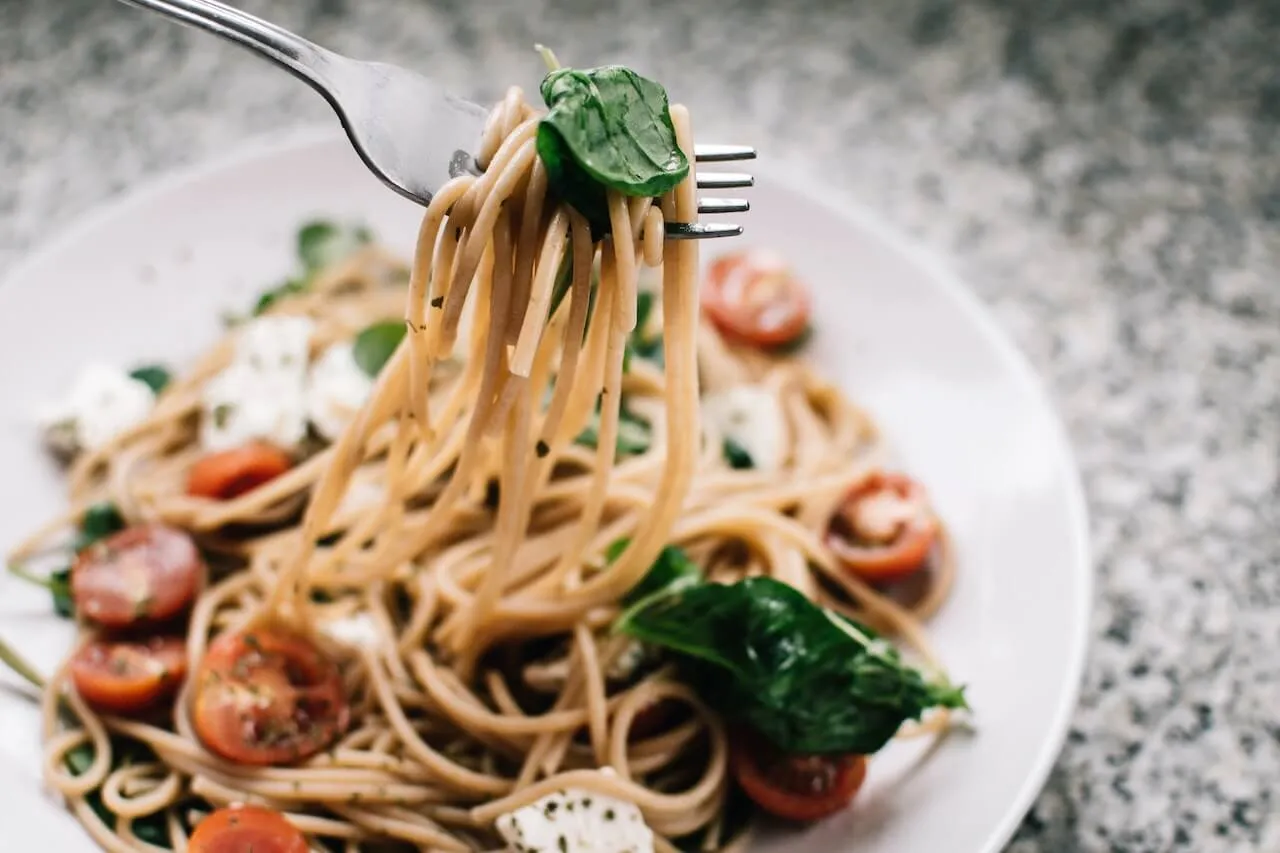Most people eat pasta 1 to 4 times per week! About 6% of Americans eat pasta daily.¹ Most pasta noodles are cooked in 8 to 12 minutes. Pasta is easy, fast, and a crowd-pleaser. Needless to say, we love pasta! But this frequency and our mega-sized portions of pasta may not love us.
What is the Nutritional Value of Pasta?
Most kinds of pasta are made from refined grains, specifically white flour. Refined grains lack fiber and protein causing the carbohydrates in pasta to be absorbed quickly and raise glucose levels quicker than whole grain or fiber-rich options. A serving of pasta is 2 oz dry (or 1 cup cooked) and provides about:
- 210 calories
- 1 gm fat
- 43 gm of carbohydrates
- 1.8 gm of fiber
- 7.4 gm of protein²,³
The glycemic index of refined flour pasta is 55 (almost a medium-high glycemic index food).⁴ A glycemic index of 56 to 69 is moderately high or medium-high. Keep in mind, we often eat more than the recommended portion size which would increase the index. The glycemic index is a 100-point scale measuring your blood glucose response after eating a specific food.
Eating an abundance of refined grains like this (like many Americans do) can contribute to cardiovascular disease and a higher risk of mortality.⁵ An increased risk for type 2 diabetes is also seen with high consumption levels from certain food groups, including refined grains.⁶
How Does Pasta Affect Blood Sugar?
Let’s jump in to understand how the body reacts to refined pasta , and more specifically what happens to blood sugars after consumption. Meat or vegetables paired with a carbohydrate will slow down the digestion rates, but will focus on carbohydrates by themselves for now..
The digestion rates of carbohydrates are determined by how much sugar, starch, and fiber exist within the particular carbohydrate. A refined carbohydrate is lower in fiber and is quickly broken down into glucose. This takes place in the small intestine where glucose is then transferred to the bloodstream, leading to a quick rise in blood glucose. But,dietary fiber (which includes resistant starch) cannot be broken down in the small intestine. This leads to delayed digestion rates and a slower blood glucose rise after a meal. Foods high in resistant starch have a lower glycemic response and a lower glycemic index.⁷
You may be wondering if you can increase resistance starches in pasta. And the answer is yes!
Cooking methods can influence the amount of resistant starch. Cooled pasta and reheated leftover pasta undergo retrogradation. As pasta cools off, its structure is rearranged,resulting in higher resistant starch content and lower blood glucose levels. A 2020 study published in Foods, showed a quicker return to fasting glucose levels with reheated leftover pasta and cooled pasta compared to hot pasta.⁷ Literally and figuratively pretty cool!
{{mid-cta}}
7 Healthy Alternatives to Traditional Pasta
Peruse this list of healthy pasta alternatives to further control your glycemic response!
Alternative Grain Pasta
Whole Wheat Pasta
Whole wheat pasta is a familiar healthy pasta alternative. It has a slightly lower glycemic index of 52 compared to refined flour pasta (glycemic index of 55).⁴ Whole wheat pasta boasts almost 3 times the fiber of regular pasta resulting in more stable glucose levels. One serving of whole wheat pasta contains:
◦ 200 calories
◦ 1.7 gm fat
◦ 42 gm of carbohydrates
◦ 5.2 gm of fiber
◦ 7.9 gm of protein⁸
Be careful not to overcook whole wheat pasta as it tends to clump together. Check these noodles a few minutes before the package recommends to ensure the best taste and texture. Whole wheat pasta doesn’t work well in soups, baked pasta, or one-pan recipes that require longer cook times. Stick to flavorful sauces and roasted vegetables that could include spicy sausage and bell peppers to pair with the nuttier flavor of the wheat pasta.
Brown Rice Pasta
Brown rice pasta is a great option for those following a gluten-free diet. This alternative pasta has a fairly similar nutritional value and glycemic index to traditional pasta with a tad bit more fiber (so may be best to eat in moderation).
◦ 211 calories
◦ 2.6 gm fat
◦ 49 gm of carbohydrates
◦ 2.6 gm of fiber
◦ 5.3 gm of protein⁹
Brown rice pasta is less finicky about overcooking even if you cook past the typical 10 minutes. This pasta has a mild flavor and any type of sauce will work! Consider adding more vegetables to bump up the fiber content and chicken for more protein to help control glycemic peaks.

Pulses Pasta
Red Lentil Pasta
Red lentil pasta is a winner in terms of nutrition and glycemic index coming in at 22!⁴ With the lowest glycemic index of all the pasta listed on this roundup, red lentil pasta won’t negatively impact blood glucose levels. Red lentil pasta provides almost all the daily needs for folate and is a great source of iron.
◦ 188 calories
◦ 1.7 gm fat
◦ 34 gm of carbohydrates
◦ 11 gm of fiber
◦ 12 gm of protein¹⁰
Research also supports higher consumption of lentils, legumes, and beans for the prevention of cancer and cardiovascular disease. Substituting regular pasta for red lentil pasta can help you bump up your intake!¹¹
Red lentil pasta has a shorter cook time of about 7 minutes and will get gummy if overcooked. Because it’s already higher in protein and fiber, you can also get away with less meat or vegetables and still have lower glycemic peaks. This nutritious and naturally gluten-free pasta deserves a chance on your meal rotation.
Chickpea Pasta
Chickpea pasta is a new staple among grocery stores. It’s a great option for those following a gluten-free diet and has quadruple the amount of fiber and almost double the protein found in regular pasta. The glycemic index is low at 44.¹² Being a legume, you will gain the same cancer and heart disease prevention benefits as red lentil pasta.
◦ 190 calories
◦ 3.5 gm fat
◦ 32 gm of carbohydrates
◦ 8 gm of fiber
◦ 14 gm of protein¹³
Chickpea pasta has a similar cook time to red lentil pasta of about 7 minutes and will gum up if overcooked. Rinse the noodles after cooking and add a flavorful red sauce with lean ground beef (or any other protein).
Pea Pasta
Pea pasta is made from green or yellow peas, which is another type of legume. Swapping out traditional pasta with a legume based pasta helps you reap the benefits of cancer and heart disease prevention, weight maintenance, and blood sugar management. It also contains key vitamins and minerals like iron and folate. The glycemic index is low at 23, almost matching red lentil pasta.⁴
◦ 196 calories
◦ 1 gm fat
◦ 38 gm of carbohydrates
◦ 6.2 gm of fiber
◦ 11 gm of protein¹⁴
Pea pasta is green if it is made from green peas. If the color makes you wary, try the yellow pea version. Again, 7 minutes is the average cook time just like the other legume pasta. There is a subtle pea flavor and most sauces will go well with this healthy pasta.

Vegetable Pasta
Spaghetti Squash
Spaghetti squash is a vegetable that is baked in the oven for 30 to 40 minutes and then easily shredded to make “pasta.” You are essentially just adding more vegetables to your meal which is a low-glycemic option. You can buy it pre-cooked in the freezer section to cut down your cook time to less than 6 minutes. This is a natural pasta alternative, but it does need to be paired with proteins and healthy fats to make a more complete meal and keep you satiated. One cup of spaghetti squash has:
◦ 42 calories
◦ 0.4 gm fat
◦ 10 gm of carbohydrates
◦ 2.2 gm of fiber
◦ 1 gm of protein¹⁵
You may need some more carbohydrates to feel full. Try adding chickpeas and kale for an added boost of nutrients and complex carbs.
Asian Pasta Alternative
Kelp Noodles
Kelp noodles are a healthy pasta alternative. They are a sea vegetable that doesn’t require cooking, just rinsing and adding to any dish. One cup of kelp noodles has:
◦ 12 calories
◦ 0 gm fat
◦ 6 gm of carbohydrates
◦ 2 gm of fiber
◦ 0 gm of protein¹⁶
Like spaghetti squash, you will need to add carbohydrates, proteins, and healthy fats to make a balanced meal. Kelp noodles go great with Asian dishes and stir-fries.
FAQs on Pasta
1. How many times per week can you eat traditional pasta?
You can eat traditional pasta one time per week in a 1-cup cooked portion. Due to the refined grains used in traditional pasta, you should add more fiber from a side salad or sautéed vegetables in the sauce. Additionally, adding 3 oz of protein like chicken, fish, or lean ground beef will further prevent high glycemic peaks.
2. Why are these alternatives better than traditional pasta?
These alternative healthy pastas add up to four times the amount of fiber and almost double the amount of protein by just swapping out the pasta type. This is a simple healthy change to stabilize your blood glucose levels before you even alter the sauce or add meat, fish, or chicken to your pasta!
3. What is the best alternative to help you lose weight?
I recommend a legume-based alternative healthy pasta (like red lentil, chickpea, or pea pasta). Legumes are very filling due to their naturally high fiber and protein content. You will likely eat less pasta too! Many health benefits beyond weight loss are related to increased consumption of legumes and beans.
Monitor Your Health, Eating Mindfully
Signos combines a continuous glucose monitor (CGM) with an app to deliver real-time glucose monitoring for optimal health and weight management. These two tools can help you monitor your personal glucose levels in response to what you eat. You can make informed choices about what to eat, how much to eat and when to eat to maintain a healthy lifestyle.
Topics discussed in this article:
References
- https://internationalpasta.org/news/it-is-handy-and-everybody-likes-it-an-international-study-reveals-that-pasta-united-the-world-during-the-lockdown/#:~:text=More%20than%20the%20number%20of,even%20eat%20it%20every%20day.
- https://www.nutritionvalue.org/Pasta%2C_cooked_56130000_nutritional_value.html
- https://nutritiondata.self.com/facts/cereal-grains-and-pasta/5779/2
- https://pubmed.ncbi.nlm.nih.gov/34828822/
- https://pubmed.ncbi.nlm.nih.gov/33536317/
- https://pubmed.ncbi.nlm.nih.gov/31960666/
- https://pubmed.ncbi.nlm.nih.gov/31881647/
- https://www.nutritionvalue.org/Pasta%2C_dry%2C_whole-wheat_nutritional_value.html?size=2+oz+%3D+56.70+g
- https://www.nutritionvalue.org/Pasta%2C_TINKYADA%2C_cooked%2C_brown_rice_flour%2C_gluten-free_nutritional_value.html?size=1+cup+fettucini+not+packed+%3D+153+g
- https://www.nutritionvalue.org/Organic_red_lentil_pasta_by_TOLERANT_516766_nutritional_value.html?size=2+oz+%3D+56.70+g
- https://pubmed.ncbi.nlm.nih.gov/29352655/
- https://www.eatbanza.com/pages/faq#:~:text=What's%20the%20glycemic%20index%20of%20Banza%20pasta%3F&text=Banza%20pasta%20is%20a%20low,feel%20comfortable%20eating%20Banza%20frequently.
- https://www.nutritionvalue.org/Rigatoni_by_Banza_LLC_553003_nutritional_value.html
- https://www.nutritionvalue.org/Green_pea_penne_pasta%2C_green_pea_by_Jagg_Marketing_2000_Inc._744814_nutritional_value.html?size=2+oz+%3D+56.70+g
- https://nutritiondata.self.com/facts/vegetables-and-vegetable-products/2655/2
- https://kelpnoodles.com/




.svg)










.svg)
.svg)
.svg)
.svg)
.svg)
.svg)
.svg)
